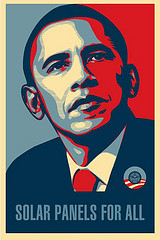
She was asking about whether the President was in trouble, due to the failure of loan guarantees to jump-start the industry. I agreed those programs had not worked, adding government has two roles in renewable energy, expanding research and guaranteeing a market.
The President has taken two important steps recently to assure a steady flow of research dollars. The first was the Defense Department's commitment of $7 billion to becoming more energy-independent. The second was the rise in CAFE standards.
Then I told her that the best possible short-term stimulus that might come from the President next week would focus on the cheapest form of renewable energy there is, something we have more of than any country in the world, something we can access cheaply and without new technology.
Efficiency.

All three should be selling for more than they are, because all three deliver value for money to people who buy what they make. Much more than a Solyndra or Evergreen Solar, which were trying to compete with Chinese labor costs head-to-head.
Most homes poor people live in are poorly insulated. Most are rental units. What if you gave the owners of those units loan guarantees for improving insulation? The investment would pay for itself from the savings, we would lower energy demand, and working people would actually benefit.
Unlike solar panels or wind farms, insulation is labor intensive. The insulation industry is local, it's mostly composed of small businesses. Give these people an incentive for hiring and most hires will be high school graduates who have the highest unemployment rate right now.
Stimulating the purchase of energy-efficient appliances, of devices that turn-off electricity when appliances are not in use, and even LED lights for ball fields and businesses provides a quick bang for the buck, puts people to work, and lowers demand for all forms of energy.
If America were as efficient in its use of energy as our economic rivals are, energy prices would be reduced and we would be more competitive in every area. The flip side of having 4% of the world's population using 25% of the world's energy means we have more of this cheap renewable energy around than any other country.

Industry has gotten the message, and energy use there has been going down for years. Commercial landlords now use more electricity than our industry does, and could put incentives to use right away. Residences can use the help and many consumers would take advantage of it.
It's easy money.











That Libération article is decent and it does quote Mr. Blankenhorn at the end.
I’ve put my own translation of it on my EuroSavant blog: Solyndra: All Is Not Lost.
That Libération article is decent and it does quote Mr. Blankenhorn at the end.
I’ve put my own translation of it on my EuroSavant blog: Solyndra: All Is Not Lost.
Routine that, tap that, manipulate that, and you’ll put more individuals to function, and get a more sure come back on any administration investing, than through any other plan. It’s probably the least debatable plan the Chief executive could suggest.
Routine that, tap that, manipulate that, and you’ll put more individuals to function, and get a more sure come back on any administration investing, than through any other plan. It’s probably the least debatable plan the Chief executive could suggest.
helpful hints
Dana Blankenhorn: A Stimulus Program That Saves Money and Creates Jobs